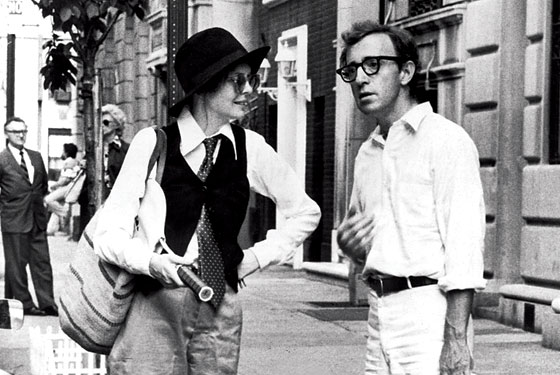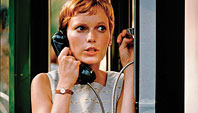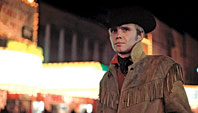 |
(Photo: Everett Collection) |
Around the time New York began life, Mayor Lindsay was encouraging Hollywood to consider the city as an exciting place to shoot. Boy, was it. The cameras arrived in an era of racial unrest, filth, and crime, and the world discovered what it was missing—for better and worse. You’ll notice that many of the movies here come from that decade. That was not by design. But if you’re looking for films that capture something emblematic about New York, it’s hard to leave out The French Connection, Taxi Driver, or Annie Hall. It’s hard to leave out Death Wish, too, even if it’s hateful. What’s had that kind of cultural impact recently? I Am Legend? If you’re upset that something you love isn’t on this list, well, so am I. And I know there are too few films directed by women—a situation that should change in the next 40 years. But what follows will conjure up New York, in all its splendor and tumult.
PLANET OF THE APES, 1968
No, it wasn’t shot in New York, but that devastating final image of the Statue of Liberty jutting out of the sand implied that the preceding ape-stravaganza had taken place in—Hoboken? The Bronx? Scarsdale? Was it a harbinger of the anarchy to come? Hell of a time to launch a magazine.
 |
(Photo: Paramount/The Kobal Collection) |
ROSEMARY’S BABY, 1968
Roman Polanski brought his gargoyle wit to Ira Levin’s sick-joke novel (right on the feminist-misogynist border) about a waifish wife (Mia Farrow) whose husband (John Cassavetes) gets a Broadway hit in return for letting Satan knock her up. Polanski changed how we thought about women’s control over their bodies—and our neighbors in New York apartment buildings.
 |
(Photo: United Artists/The Kobal Collection) |
MIDNIGHT COWBOY, 1969
Everybody was talkin’ at Jon Voight, especially Dustin Hoffman’s scuzzy Ratso Rizzo, in John Schlesinger’s Oscar winner, which dramatized how New York turns nice Texas boys into prostitutes and killers. But oh, the people you meet!
HOSPITAL, 1970
In this wrenching vérité documentary, Frederick Wiseman captured the plight of sick poor people in an era of crumbling city services. It was at once ultrareal and a metaphor for urban indignity.
EL TOPO, 1970
At 12 a.m., Alejandro Jodorowsky’s splattery, nihilist Mexican Western packed the Elgin and became the first “midnight movie.” Later, audiences fell hard for The Harder They Come, gagged as one when Divine devoured a fresh doggy turd in Pink Flamingos, and shrieked back at The Rocky Horror Picture Show. Anything that flopped with the staid and the straight had a shot at keeping the city that never sleeps awake.
SHAFT, 1971
The uptown audience had never seen anything like this action hero who mocked whitey’s law, screwed (and threw away) whitey’s women, and exulted in his own potency.
THE FRENCH CONNECTION, 1971
Pauline Kael wrote that on-location shooting had ushered in a new age of “nightmare realism,” with New York as “Horror City.” Here was Exhibit A: trash, horns, gore, Gene Hackman’s Popeye Doyle slapping suspects around, and a chase scene yet to be equaled for suspense and public endangerment.
DEEP THROAT, 1972
It was shot in Florida, but Linda Lovelace’s talent captured New York’s imagination. Everyone—the raincoat crowd, the intelligentsia, the middle-class-curious-yellow—wanted to see the first hetero porn film with blow jobs. The prosecutor who sued to close the theater (he won) seemed most alarmed by the suggestion that it was “normal to have a clitoral orgasm.”
MEAN STREETS, 1973
Martin Scorsese grew up in Little Italy, studied at NYU, and crafted a feverishly expressionistic portrait of small-time hoods and neighbors that felt so rich, so rooted, that audiences took it for realism. A New York film style was born—and so were the careers of Harvey Keitel and the phenom that was Robert De Niro.
DEATH WISH, 1974
The urban-vigilante template. Bernie Goetz came a decade later; the rest of the crowd lived vicariously and learned to love the death penalty.
THE GODFATHER PART II, 1974
The first part was a better piece of storytelling, but Francis Coppola’s follow-up enlarged our understanding of the immigrant experience, from Ellis Island to Little Italy to the ’burbs to Lake Tahoe, as a vibrant sense of community gave way to chilly isolation. Are there many sequences greater than the rooftop trek of De Niro’s avenging Vito Corleone above the Festival of San Gennaro?
DOG DAY AFTERNOON, 1975
Al Pacino robs a bank to fund a sex-change operation for his lover, and all hell breaks loose—“all hell” meaning “New York squared.” As Pacino madly fires up the crowds (“Attica! Attica!”), we get a concentrated dose of what drives so many New Yorkers: enraged entitlement, a wide streak of exhibitionism, and a nagging sense that all will not end well.
TAXI DRIVER, 1976
Death Wish inside out, with the psycho innards exposed. Paul Schrader wrote a Dostoyevskian odyssey based on nights prowling the Deuce, and Scorsese and De Niro transformed it into a hallucinatory expression of urban alienation—of “morbid self-attention” and rage in search of release. “Everybody’s talkin’ at me” was now, “You talkin’ to me?”—Blam!
NETWORK, 1976
New York in the seventies was the perfect setting for ex–TV writer Paddy Chayefsky’s anti-television broadside, which anticipated ugly-spirited reality shows and their soulless producers (embodied by Faye Dunaway and her cheekbones). Audiences mimicked unhinged newsman Howard Beale (Peter Finch) and screamed, “I’m mad as hell, and I’m not gonna take it anymore!” Purged, they take it still.

